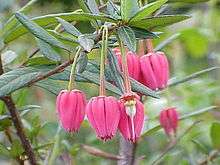Elaeocarpaceae
| Elaeocarpaceae Temporal range: Santonian–Recent[1] | |
|---|---|
 | |
| Crinodendron hookerianum | |
| Scientific classification | |
| Kingdom: | Plantae |
| (unranked): | Angiosperms |
| (unranked): | Eudicots |
| (unranked): | Rosids |
| Order: | Oxalidales |
| Family: | Elaeocarpaceae Juss. ex DC.[2] |
| Genera | |
|
Aceratium | |
Elaeaocarpaceae is a family of flowering plants. The family contains approximately 615 species of trees and shrubs in 12 genera.[3][4] The largest genera are Elaeocarpus, with about 350 species, and Sloanea, with about 150.
The species of Elaeocarpaceae are mostly tropical and subtropical, with a few temperate-zone species. Most species are evergreen. They are found in Madagascar, Southeast Asia, Australia, New Zealand, West Indies, and South America.
The plants are hermaphrodite or dioecious and bear flowers clustered in inflorescences.
A phylogeny of the family, based on DNA sequences was published in 2006.[5]
Alkaloids Katavic 2005
References
- ↑ Stevens, Peter F. "Elaeocarpaceae". APWeb. Retrieved 2013-12-04.
- ↑ Angiosperm Phylogeny Group (2009). "An update of the Angiosperm Phylogeny Group classification for the orders and families of flowering plants: APG III" (PDF). Botanical Journal of the Linnean Society. 161 (2): 105–121. doi:10.1111/j.1095-8339.2009.00996.x. Retrieved 2013-07-06.
- ↑ Christenhusz, M. J. M. & Byng, J. W. (2016). "The number of known plants species in the world and its annual increase". Phytotaxa. Magnolia Press. 261 (3): 201–217. doi:10.11646/phytotaxa.261.3.1.
- ↑ Darren M. Crayn, Maurizio Rossetto, and David J. Maynard. 2006. "Molecular phylogeny and dating reveals an Oligo-Miocene radiation of dry-adapted shrubs (former Tremandraceae) from rainforest tree progenitors (Elaeocarpaceae) in Australia". American Journal of Botany 93(9):1328-1342.